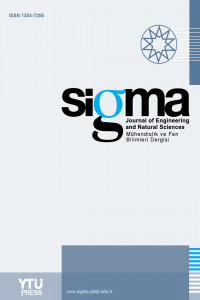Abstract
Cutting tools used in machining operations have slight roundness on the cutting edge regardless of their manufacturing methods. In some cases, edge of the cutting tool is specially rounded. In this study, effects of flank wear rate, cutting edge radius, uncut chip thickness, cutting speed and rake angle on cutting force, thrust force and resultant force were experimentally investigated in orthogonal cutting operations. Cutting tools having 50 μm, 125 μm and 200 μm flank wear rates and 50 μm, 100 μm and 150 μm cutting edge radii were used in experiments carried out by using quick-stop orthogonal cutting device. Experiments were carried out at three different uncut chip thicknesses (100 μm, 150 μm and 200 μm) and cutting speeds (0,25 m/dak, 0,5 m/dak and 0,75 m/dak) and two different rake angles (2° and 6°) and effects of flank wear rate, cutting edge radius and cutting parameters on cutting forces were determined. Cutting forces increased when flank wear rate, cutting edge radius and uncut chip thickness increased and slightly decreased when cutting speed and rake angle increased. Besides, micro views of the samples obtained from quick-stop device were analyzed and the effects of flank wear rate on dead metal zone formed in front of the tool were investigated. It was seen that dead metal zone became smaller when flank wear rate increased.
References
- The article references can be accessed from the .pdf file.
Details
| Primary Language | English |
|---|---|
| Subjects | Industrial Biotechnology |
| Journal Section | Research Articles |
| Authors | |
| Publication Date | September 1, 2013 |
| Submission Date | September 18, 2012 |
| Published in Issue | Year 2013 Volume: 31 Issue: 3 |
IMPORTANT NOTE: JOURNAL SUBMISSION LINK https://eds.yildiz.edu.tr/sigma/


